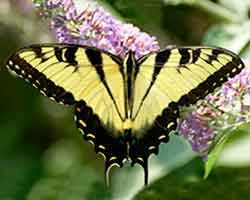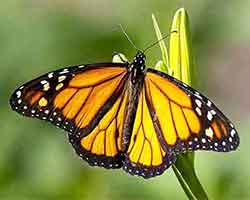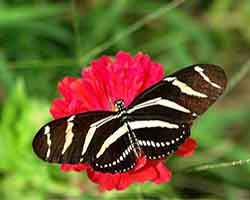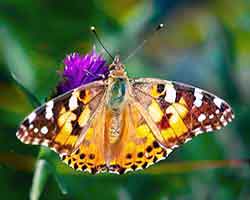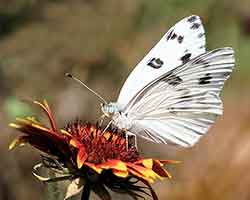- Home
- Butterfly Paintings
- Butterfly Types
Thirty or More Types of Butterflies You May See Around Your Garden
These types of butterflies are seen in the United States. Use the photos and information to identify the butterflies you see.
Gain a deeper appreciation for the natural beauty that thrives in our own backyards. People have admired butterflies for centuries.
The stunning Blue Morpho Butterfly (photo below) is a popular attraction in public butterfly gardens. They are an amazing gift from God.
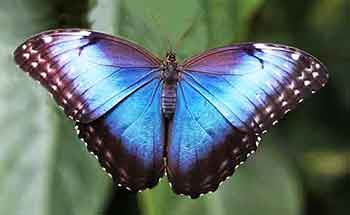 It's fun learning the butterflies.
It's fun learning the butterflies.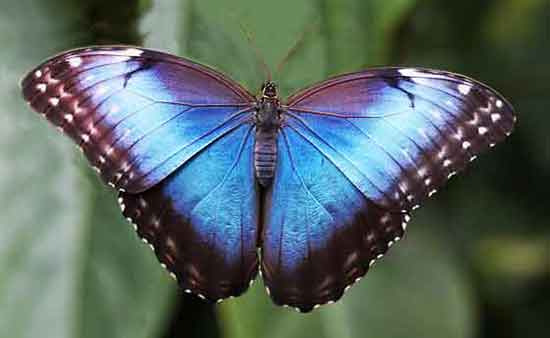 It's fun learning the butterflies.
It's fun learning the butterflies.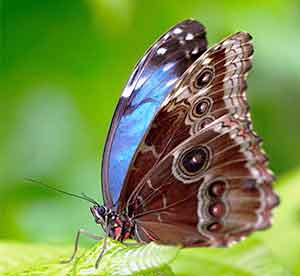 Blue Morpho
Blue MorphoAmazingly, their beautiful blue wings are brown on the underside. This camouflages them when their wings are up.
The Blue Morphos are not native to the United States. Instead, they are from the tropical forests of Mexico, Central and South America.
They are quite large for a butterfly with their wing-span often reaching eight inches.
Let's look at butterflies that live in the states.
Types of Butterflies Seen in the United States
Identify the general type and click down the page for more information.
How do we tell a moth versus a butterfly?
Swallowtail Butterflies
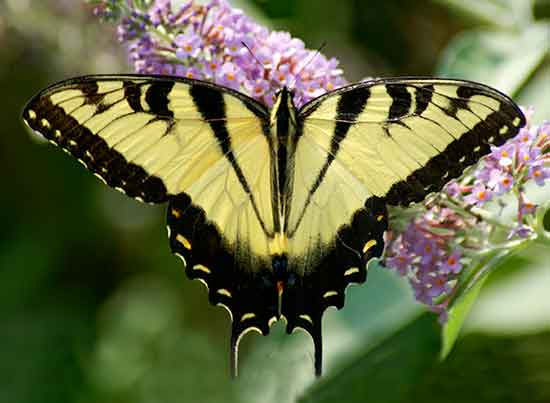 Their tails identify the group of swallowtails.
Their tails identify the group of swallowtails.The types of butterflies known as Swallowtails are the most recognizable butterflies in the United States. They capture our imagination with their distinctive elongated tails and vibrant colors.
They are noted for their impressive size, with wingspans that can reach up to six inches.
There is often a false eye on the swallowtail. It is for their protection to keep birds from pecking their real eyes.
These magnificent butterflies are found in a wide range of environments from forests to our backyard gardens.
Black Swallowtail
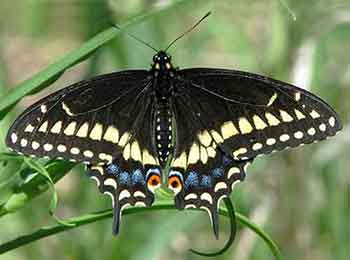 Black Swallowtail
Black SwallowtailThe male Black Swallowtails have an orange spot on the back of the hind-wing. The orange spot on both male and females has black in the center of the orange spot.
2 1/2" to 3 1/2"
Black Swallowtail
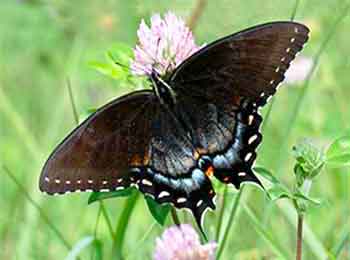 Black Swallowtail, female
Black Swallowtail, female
The black swallowtails are wide-spread from southern
Canada to Florida, thru the mid-western states to the west side of the
Rocky Mountains and southwest into Arizona, southern California and into northern Mexico.
Black Swallowtail
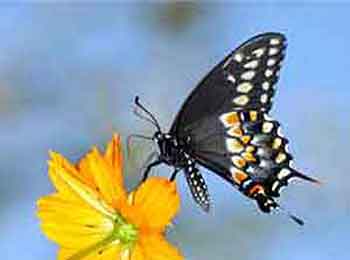 Black Swallowtail
Black SwallowtailBlack Swallowtails lay their eggs on carrot plants, parsley, dill and fennel.
Art by Carol May
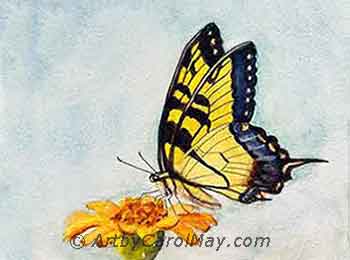 WC Butterfly Painting
WC Butterfly PaintingIt's my joy to do butterfly paintings, hummingbirds, flowers and landscapes.
Eastern
Tiger Swallowtail
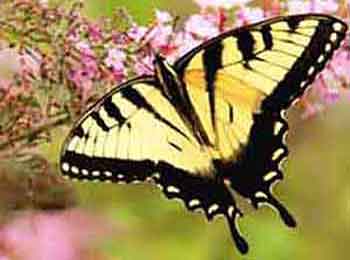 Eastern Tiger Swallowtail
Eastern Tiger SwallowtailThis stunning butterfly is one of my favorite types of butterflies. The bold 'tiger' stripes make it easy to recognize.
It;s a large butterfly that flies so softly.
3 1/2" to 5 1/2"
Eastern
Tiger Swallowtail
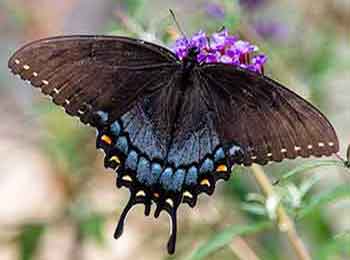 Brown Tiger Swallowtail
Brown Tiger SwallowtailThere is a brown form of some of the female Tiger Swallowtails.
All forms are seen in the eastern United States from Maine to Florida and west into the Great Plains.
Western
Tiger Swallowtail
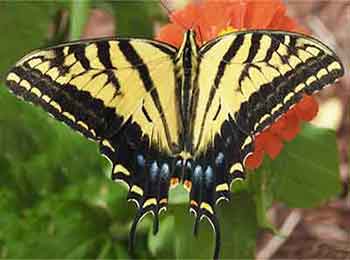 Western Tiger Swallowtail
Western Tiger SwallowtailThe Western Tiger Swallowtail is smaller than the Eastern Tiger Swallowtail. It has an orange and several blue spots on each hind-wing, plus double swallowtails.
3" to 4"
Tiger Swallowtails
Puddling
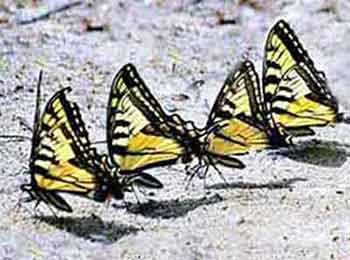 Tiger Swallowtail Butterflies
Tiger Swallowtail ButterfliesMale Tiger Swallowtail butterflies getting minerals from the wet soil.
Only male butterflies do this to get the extra minerals.
Pipevine Swallowtail
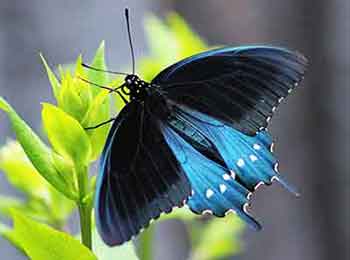 Pipevine Swallowtail
Pipevine SwallowtailThis beautiful butterfly is seen from the Great Lakes to Southern California and down into Central America.
2 3/4" to 3 1/2"
Spicebush Swallowtail
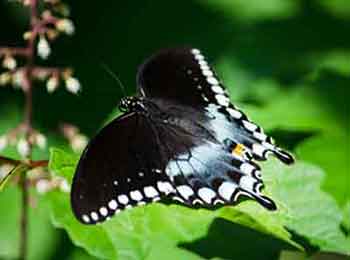 Spicebush Swallowtail
Spicebush SwallowtailThe hind-wings are bluish or white. The orange spot on the hind-wing has no black in the center like Black Swallowtails.
3 1/2" to 4 3/4"
Palamedes Swallowtail
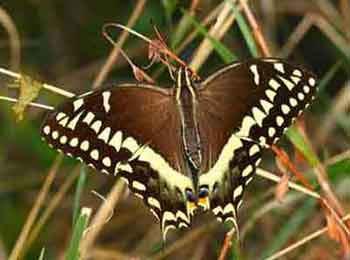 Palamedes Swallowtail
Palamedes SwallowtailThe Palamedes Swallowtail is seen in the swampy areas along the Southeastern United States down to the gulf coast.
They are distinctively larger than Black Swallowtails and brownish-black.
4 1/2" to 5 1/8"
Zebra Swallowtail
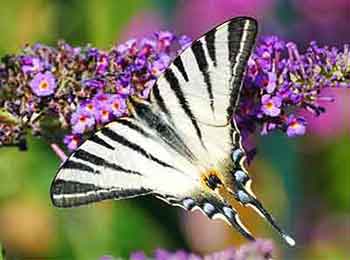 Zebra Swallowtail
Zebra SwallowtailThe Zebra Swallowtail of the eastern US may be confused with a Tiger Swallowtail.
It is black and white without any yellow. Also, it is considerably smaller than the Tiger Swallowtails.
2 1/2" to 3 1/2"
Giant Swallowtail
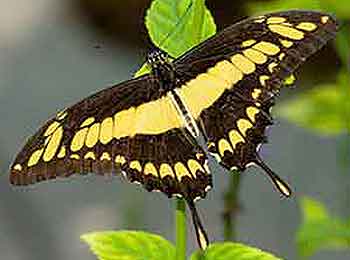 Giant Swallowtail
Giant SwallowtailThe Giant Swallowtail is one of the largest butterflies in North America. Its wing-span is up to 6". Some males can be 7" or more.
They reside east of the Rockies to the east coast and down to South America.
Giant Swallowtail
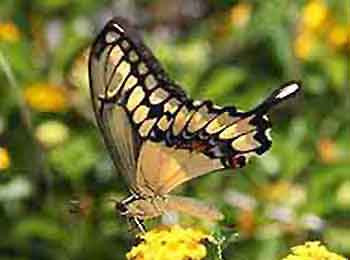 Giant Swallowtail, underside
Giant Swallowtail, undersideTheir top is bright yellow and black. The underside is mostly pale yellow with black markings.
It's hard to tell it is the same butterfly until you see it with its wings both open and closed.
Milkweed Butterflies
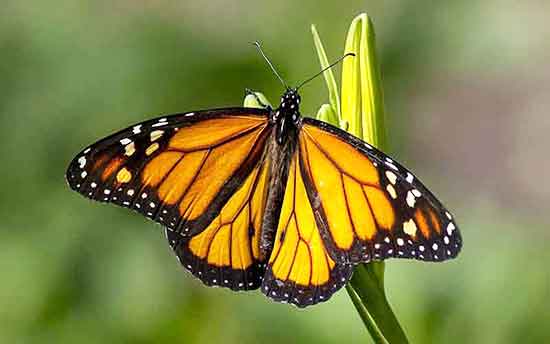 Notable Milkweed Butterflies
Notable Milkweed ButterfliesMilkweed Butterflies stand out from others types of butterflies for their remarkable adaptations.
They are pretty smart. They feed on milkweeds that contain cardiac glycoside. They have developed a tolerance for this chemical, but it is toxic to birds. So, the birds don't try to eat them.
From the vibrant colors of the Monarch to the intriguing patterns of the Queen Butterfly this group offers a glimpse into the intricate web of life that sustains our natural ecosystems.
Monarch Butterfly
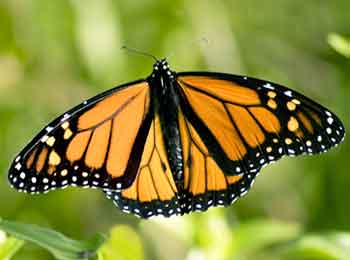 Monarch Butterfly
Monarch ButterflyMonarchs have no white spots out in the middle of their fore-wings.
They live from Canada to South America, Pacific islands, Hawaii and New Zealand.
3 1/2" to 4"
Monarch Butterfly
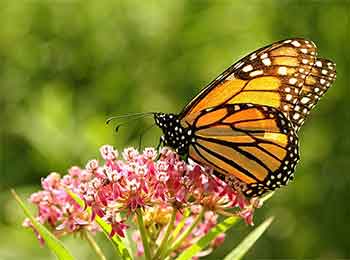 Monarch Butterfly, underside
Monarch Butterfly, undersideMonarch Butterflies are the most well-known types of butterflies.
They are famous for their amazing life cycle and annual migration from the United States to Mexico and back again.
Queen Butterfly
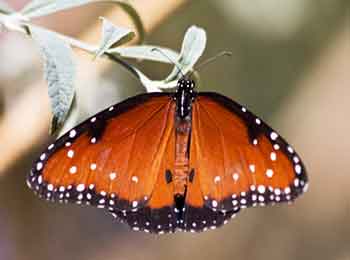 Queen Butterfly
Queen Butterfly
Queen Butterflies are seen from southern California to South Georgia and Florida down to Argentina.
3" to 3 1/2"
Queen Butterfly
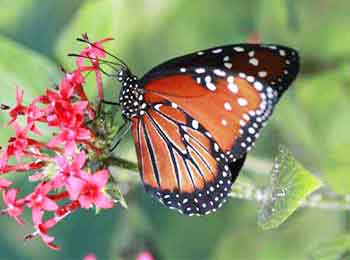 Queen Butterfly, underside
Queen Butterfly, undersideThe Queen Butterfly may be confused with the Monarch, but it lacks the black veins of the Monarch. It also
has white spots in the orange of the fore-wing.
Longwing Butterflies
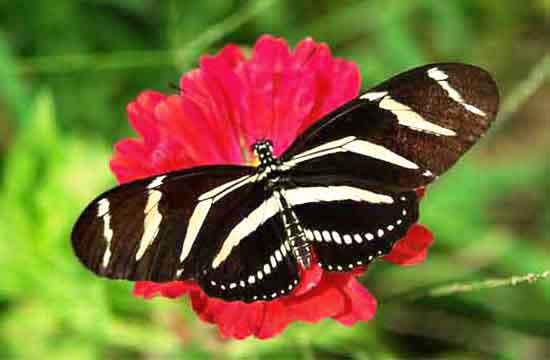 The wing-shape identifies these butterflies.
The wing-shape identifies these butterflies.The Longwing Butterflies, Heliconius are actually part of the Brush-footed family of butterflies.
But who looks at their feet, it's much easier to see their long wings. Their fore-wings are longer than they are wide.
From the striking patterns of the Zebra Longwing to
the vibrant Gulf Fritillary this group of butterflies are a treat when we see them visiting our gardens.
Zebra Longwing
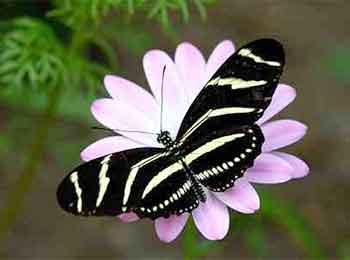 Zebra Longwing
Zebra LongwingZebra Longwings are the Florida State Butterfly.
They live several months longer than other butterflies.
2 3/4" to 3 1/2"
Julia Butterfly
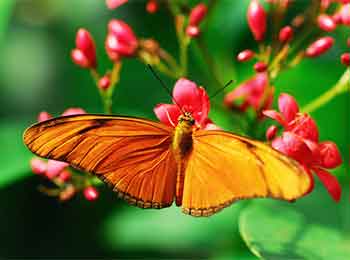 Julia Butterfly
Julia ButterflyThe Julia Butterfly, sometimes called Orange Longwing is actually a brush-footed butterfly.
But its wings are distinctly long.
3 1/4" to 3 1/2
Gulf Fritillary
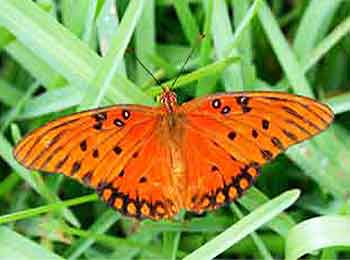 Gulf Fritillary Butterfly
Gulf Fritillary ButterflyThe Gulf Fritillary is one of the most common butterflies in Florida. They have long orange wings with dark spots.
2 1/2" to 3 3/4"
Plant some Butterfly Flowers.
Gulf Fritillary
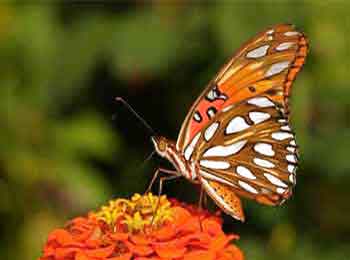 Gulf Fritillary, underside
Gulf Fritillary, undersideThey have large silvery spots on the underside of their wings.
When you see the underside, you may think they are different types of butterflies until you see both sides.
Brush-footed Butterflies
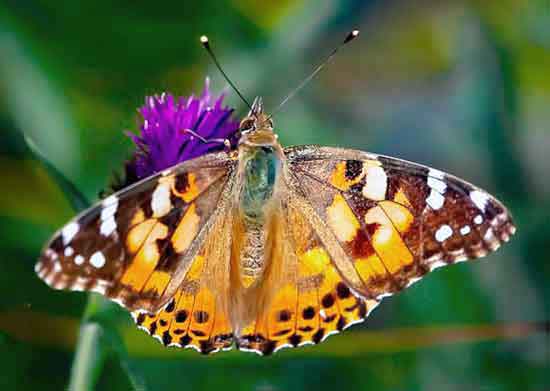 Brush-footed Butterfly
Brush-footed ButterflyThe Brush-footed types of butterflies are a diverse and fascinating group.
They are named for their distinctive front legs that look a brush. They walk and stand mainly on their four back legs.
We probably don't look at their legs, but they are also known for their intricate patterns and bold colors. This group of showcases the incredible adaptability and resilience of these winged wonders.
Viceroy Butterfly
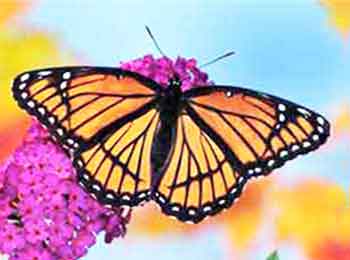 Viceroy Butterfly
Viceroy ButterflyThe Viceroy is seen in the states east of California. It's often confused with the Monarch.
It has a heavy black band across the hind-wing that's not on the Monarch.
Viceroy Butterfly
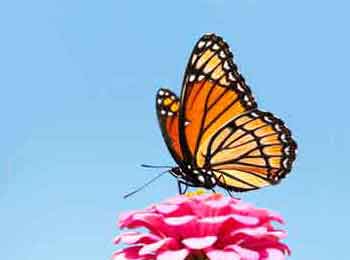 Viceroy Butterfly, underside
Viceroy Butterfly, undersideThe band also shows on the underside of the wing. Monarchs don't have a black band.
The Viceroy, at 2 1/2" to 3" is smaller than Monarchs which are 3 1/2" to 4"
Painted Lady
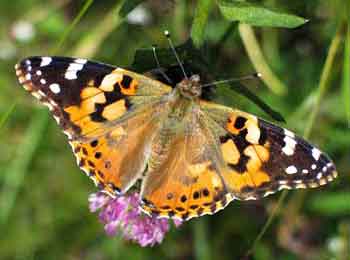 Painted Lady
Painted LadyPainted Ladies are seen in many parts of the world. They have very interesting patterns on the underside of their wings.
2" to 2 1/4"
American Painted Lady
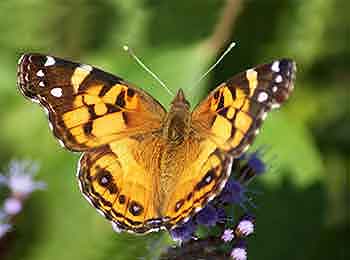 American Painted Lady
American Painted LadyThe American Painted Lady has a large eye-spot on the back wings. The Painted Lady does not have this eye-spot.
2" to 2 1/4"
Malachite Butterfly
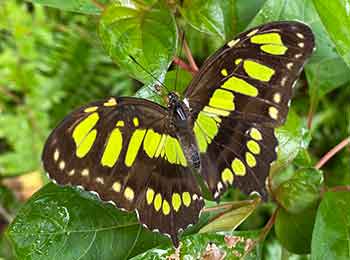 Malachite Butterfly
Malachite ButterflyThe Malachite sports green patches with dark brown to black. It is seen in the southeastern states, mainly Florida and south Texas.
3" to 4"
Great Spangled Fritillary
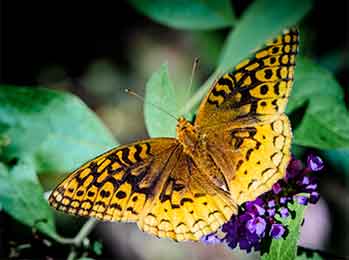 Great Spangled Fritillary
Great Spangled FritillaryThe Great Spangled Fritillary is a common butterfly throughout much of the eastern United States. The underside has silvery white spots.
2 1/8" to 3"
Buckeye Butterfly
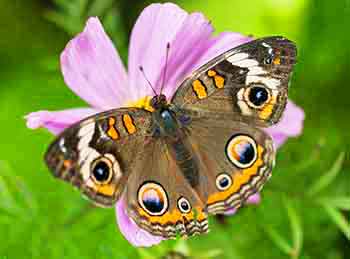 Buckeye Butterfly
Buckeye ButterflyI see the Buckeyes often and they are one of my favorites because I see them so often.
They reside throughout the United States, southern Canada and some of the Caribbean.
2' to 2 1/2"
Red Admiral Butterfly
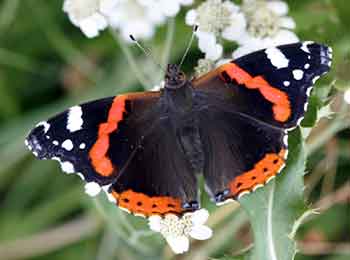 Red Admiral Butterfly
Red Admiral ButterflyThe first time I saw a Red Admiral Butterfly I was amazed at their brilliant red coloring.
It can be seen throughout the United States, Europe, central Asia and North Africa.
1 3/4" to 2 1/4"
White Peacock Butterfly
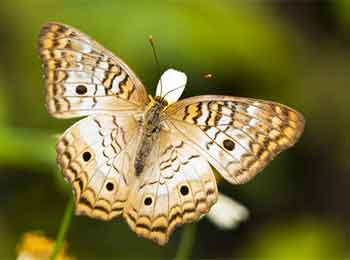 White Peacock Butterfly
White Peacock ButterflyThe White Peacock Butterfly is seen in south Texas and Florida and down through Mexico, Central America and into Venezuela.
It flies close to the ground. The first one I ever saw was sitting on the grass.
2 1/8" to 2 3/4"
Pearl Crescent
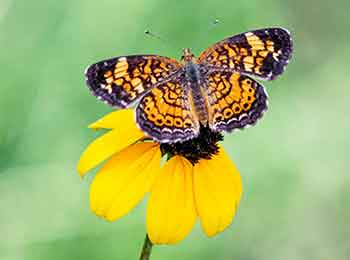 Pearl Crescent Butterfly
Pearl Crescent ButterflyThe Pearl Crescent Butterfly has pearl colored crescents inside of the black edge of the hind-wings.
It lives in much of the United States, excluding the west coast, Canada and Mexico.
1" to 1 1/3"
Red-spotted Purple
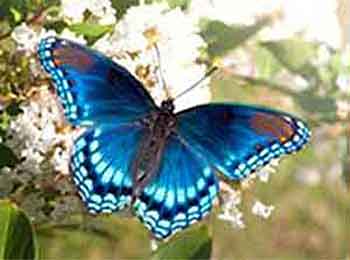 Red-spotted Purple Butterfly
Red-spotted Purple ButterflyThis beautiful butterfly is seen in much of the eastern United States. The purplish-orange color is on the end of the wings.
It mimics the Pipevine Swallowtail which is toxic. But they do not have a swallowtail.
3" to 3 3/8"
Question Mark Butterfly
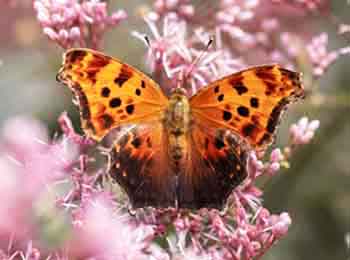 Question Mark Butterfly
Question Mark ButterflyThe Question Mark Butterfly has a question mark on the underside of its hind-wing. Its wing edges look ragged.
It is from southern Canada and the United States east of the Rockies, except Florida.
2 3/8" to 2 5/8"
White and Sulphur Butterflies
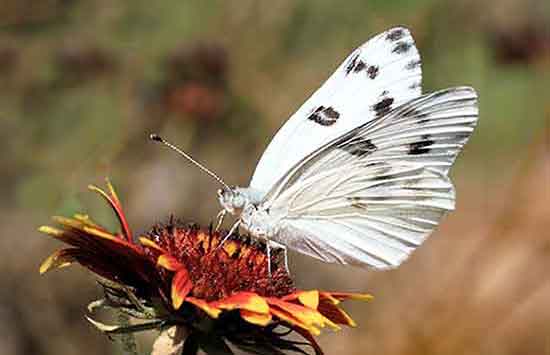 Checkered White Butterfly
Checkered White ButterflyWhite and Sulphurs are just like their names imply, either white or sulphur, yellow colored.
Both sulphur and white butterflies are small and numerous. They are the most common types of butterflies in the United States.
Sulphur Butterflies are small pale to bright yellow, sometimes with variations of orange.
White butterflies come with various markings as noted below.
Cabbage White
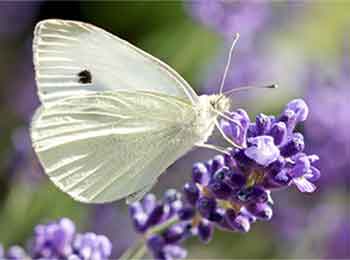 Cabbage White
Cabbage WhiteThe Cabbage White is the most numerous white butterflies across the United States.
The tip of their fore-wing is edged in black. Females have two black spots on the fore-wing, males have one spot.
Their larva are pests on cruciferous vegetables.
1 1/2" to 2"
Great Southern White
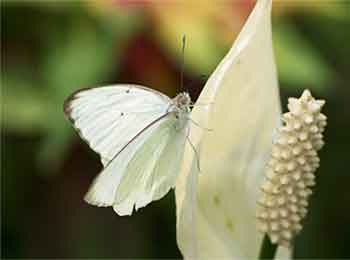 Great Southern White
Great Southern WhiteThe Great Southern White butterflies are white with a dark edge on the fore-wing.
They live in Florida, across the Gulf states to Texas and up the east coast as far as Maryland. Occasionally, they have been sighted in Colorado, Missouri, Kansas and the Dakotas.
2 1/2" to 3"
Western Pine White
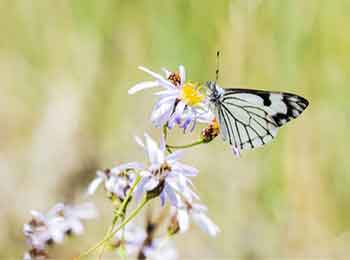 Western Pine White
Western Pine WhiteThe beautifully marked Western Pine White Butterfly is named for their caterpillars that feed on the needles of pine and fir trees.
They are seen from western Nebraska and west to the Pacific.
1 3/4" to 2 1/4"
Checkered white
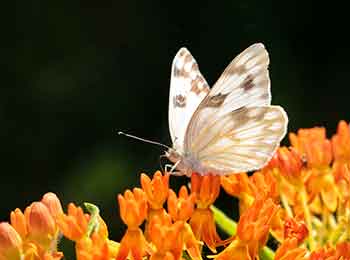 Checkered White
Checkered WhiteCheckered Whites have patterned fore-wings and faint marks on the hind-wing. The male’s markings are black and the female’s are brown.
They are residents in the southern states and seasonally north to Canada.
1 1/2" to 2 1/2"
Cloudless Sulphur
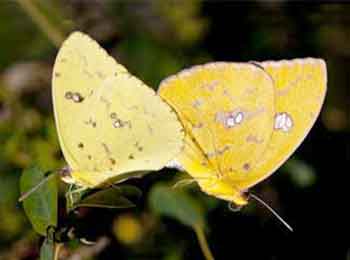 Cloudless Sulphurs
Cloudless SulphursThe Cloudless Sulphur are lemon to pale yellow. The females may fade to white. Their wings have tiny dark edges.
They are seen all across the lower fifty states. They live year-round in south Texas, throughout the deep south and Florida.
2 " to 2 3/4"
Orange Sulphur
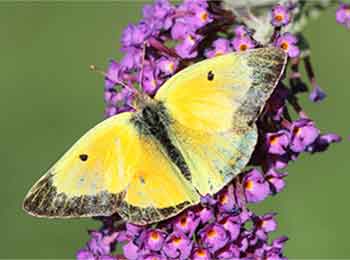 Orange Sulphur
Orange Sulphur
Orange Sulphurs, Alfalfa Butterflies are yellowish orange to white in some females.
The topside of the wings has dark borders and
one black spot on each fore-wing. They live across the states, except Florida.
1 3/8" to 2 3/4"
Skipper Butterflies
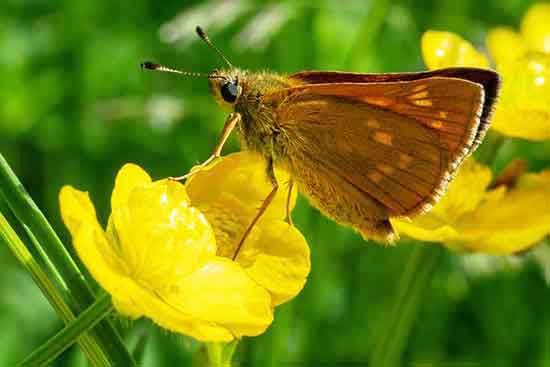 The European Skipper now resides here.
The European Skipper now resides here.Skippers are a diverse type of butterfly often overlooked. These small, fast-flying butterflies, named for their distinctive flight pattern.
Their wings are small in proportion to their body, so they fly in a hurry. They 'skip' from flower to flower.
Skippers contribute to the health of our ecosystems by serving as important pollinators.
Guava Skipper
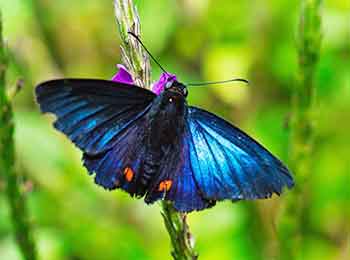 Guava Skipper
Guava SkipperThe Guava Skipper resides in south Texas. Their red-colored larva feed on Guava plants.
1 5/8" to 2 1/2".
Checkered Skipper
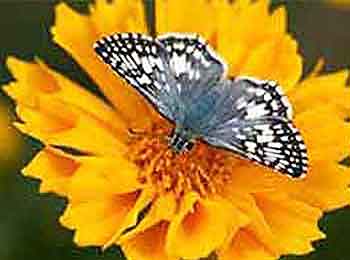 Checkered Skipper
Checkered SkipperThe delightful little Checkered Skipper is seen from southern Canada down into Argentina.
3/4" to 1 1/4"
Long-tailed Skippers
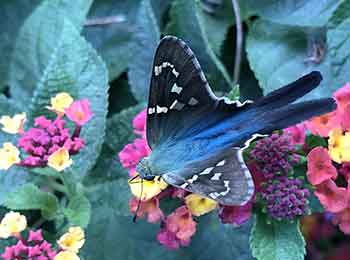 Long-tailed Skipper
Long-tailed SkipperThese dark skippers have a blue-green iridescence and a long tail. They live in the southern United States to Argentina.
1 3/4" to 2 1/4"
Silver-spotted Skipper
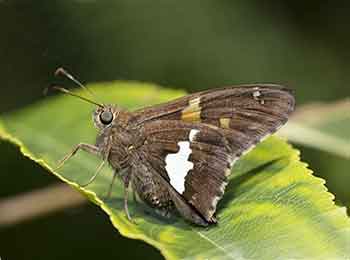 Silver-spotted Skipper
Silver-spotted SkipperThe Silver-spotted Skipper is easy to identify. It is seen from southern Canada down to Florida and northern Mexico.
1 3/4" to 2 3/8"
It's Fun Learning the Types of Butterflies Visiting Our Yards
Whether we know the names of the butterflies is not as important, as
enjoying these wonderful garden gifts.
Moths vs Butterflies: How Do We Tell the Difference?
Even though they are related, there are distinct differences between moths vs butterflies.
Moths are the unsung members of the Lepidoptera order of insects. Lepidoptera are less than ten percent butterflies and about ninety percent moths.
Some moths are just as pretty as butterflies. In fact, some of them are quite amazing in appearance.
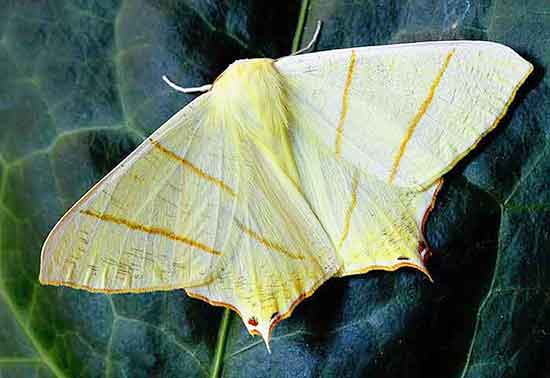 Some moths are as pretty as a painting.
Some moths are as pretty as a painting.The Differences Between Moths vs Butterflies
If there are so many moths, why don't we see more? We quite often see butterflies visiting our garden flowers.
There
are seven ways to tell a moth from a butterfly just by looking. Plus, a
couple more differences that aren't so easy to see.
#1 Moths and Butterflies Work Different Shifts
Years ago, my husband and I were tromping through the deep woods of Florida. We came upon a beautiful critter hanging on the side of a tree trunk in the shade.
It was fairly large with a long swallowtail. It just hung there and didn't fly away while we admired it in amazement.
Because it was so pretty, I thought it was a butterfly.
We found out later that it was a moth. Now it makes sense because like other moths, it was resting from its night time activities.
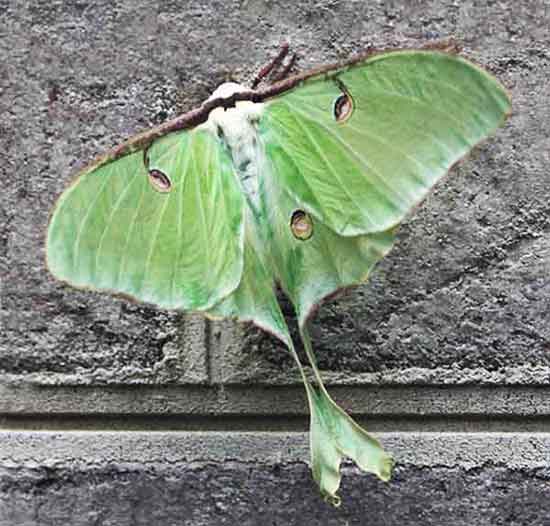 Luna Moths look like large green butterflies.
Luna Moths look like large green butterflies.
MOTHS are mostly nocturnal. They work at night and rest during the day.
BUTTERFLIES are active only during the daytime. While it's light, they are out visiting flowers.
Check it out. Go out by a street light or porch light at night. We can see all kinds of interesting moths flying around the lights.
Sometimes we see them landing on the exterior of our windows at night. The lights inside the house attract them to our windows.
#2 Moths vs Butterflies: Watch Them When They Land
MOTHS land and sit down to rest with their wings stretched
out.
When BUTTERFLIES land, they fold their wings up above their head.
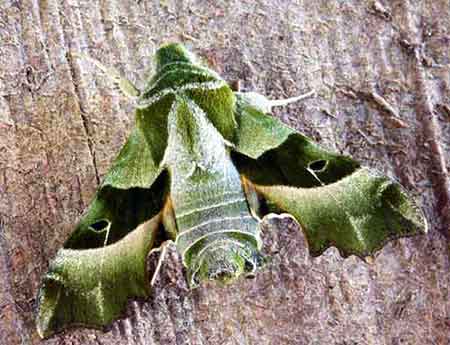
A Willowherb Hawk-moth resting with its wings out.
Notice the moth looks hairy compared to the butterfly's lightweight, smooth body.
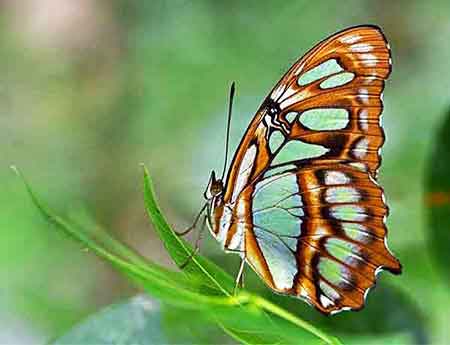
This Malachite Butterfly landed with its wings up.
You can paint this lovely butterfly in oils with a step-by-step butterfly tutorial.
#3 Moths vs Butterflies: They Are Colored Differently
Most MOTHS have duller colors. BUTTERFLIES tend to have brighter colors.
The moth and butterfly above both have green colors, but the moth's green colors are dull.
The dull colors on moths don't attract the attention of predators while they are resting during the daytime.
#4 Moths Look Fuzzy or Furry
Both butterflies and moths have scales on their wings and bodies.
The scales on MOTHS stand up and look like fuzz or fur. The scales on BUTTERFLIES lay flat, so they look smoother.
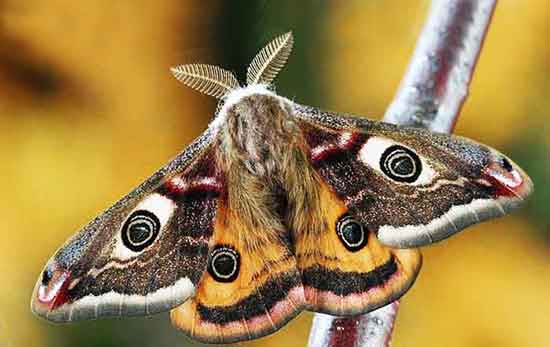 Emperor Moth from the UK
Emperor Moth from the UK#5 The Antennae of
Moths vs Butterflies
The MOTH'S antennae are feathered or leaf-like.
The BUTTERFLY'S antennae are long, smooth and slender. Generally, there is a small bulb on the end of a butterfly's slim antennae.
#6 Moths Tend to Have Heavier Bodies
MOTHS have a thick, heavy body. Consequently, they fly slower than the light weight butterflies.
The BUTTERFLY'S body is slimmer and lighter weight.
#7 Wing Devices
MOTHS have a frenulum, which is a wing-coupling device.
This mechanism locks their fore-wing and hind-wing together. So, when they fly, their wings fly in unison.
BUTTERFLIES don't have this
mechanism.
 Sphinx Moths make tomato worms.
Sphinx Moths make tomato worms.#8 The Eyes of Moths vs Butterflies
Moths have different eyes from butterflies that enables them to see better at night.
MOTHS,
as well some beetles and crustaceans have superposition eyes. These
eyes allow them to see things much brighter in low light. But they don't
see quite as clearly.
BUTTERFLIES on the other hand have opposition eyes for daytime vision.
Both moths and butterflies see colors.
#9 The Life Cycle of Moths vs Butterflies
Both moths and butterflies go through complete metamorphosis.
The adult female moth or butterfly lay eggs that hatch into caterpillars or in moths they may be called worms.
The next stage is the difference between moths and butterflies.
MOTHS spin a cocoon covered with strands of silk. BUTTERFLIES make a smooth shelled chrysalis that hatches into an adult butterfly.
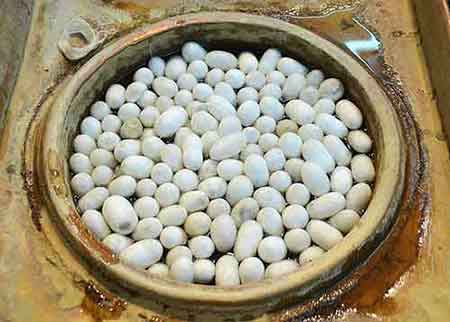 Cocoons of the Silk Moth getting processed.
Cocoons of the Silk Moth getting processed.In the orient silk moths are raised to collect their cocoons to make silk cloth. That's how we get beautiful silk clothes.
No wonder real silk costs so much.
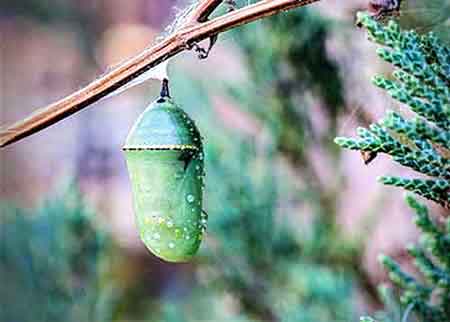 Chrysalis of a Monarch Butterfly
Chrysalis of a Monarch ButterflyDuring this stage of metamorphosis all butterflies make a chrysalis, sometimes called a pupa.
Monarchs make particularly pretty ones.
Defense Mechanisms of Moths and Butterflies
Many moths and butterflies have what is called an eye-spot. The eye-spot is normally located on the outer portion of the wings.
Most times are two concentric circles with a dark spot in the middle. The dark spot mimics the pupil of mammals.
The eye-spot is a defense mechanism that works one of two ways. Either the eye-spot would scare a predator away. Or a bird would peck the eye-spot instead of the actual eye.
Then the moth or butterfly would only lose a bit of wing instead of their whole head.
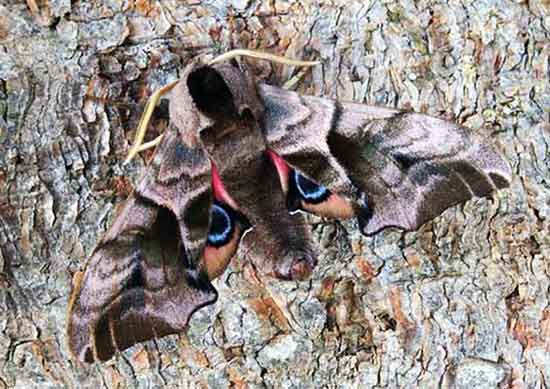 A well camouflaged Eyed Hawk Moth
A well camouflaged Eyed Hawk MothHow Do We Know the Photo Above Is a Moth?
- It's resting with its wings out.
- It is dull colored.
- It has a heavy body.
- The body and wings look furry.
- Its antennae are thick, not slim like a butterfly's.
We can't tell by the photo if it's day or night, if there's a wing-coupling of the type of eyes. And we haven't seen it making a cocoon or a chrysalis.
But these five items definitely identify it as a moth!
